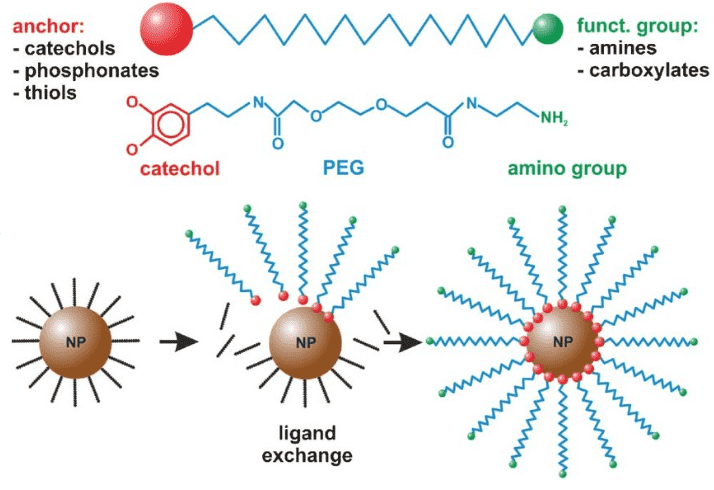- Home
-
Products
- Magnetic Ionic Liquid
-
Magnetic Beads
- Streptavidin Magnetic Beads
- Aldehyde Magnetic Beads
- Alkynyl Magnetic Beads
- Amino Magnetic Beads
- Avidin Magnetic Bead
- Azide Magnetic Beads
- Carboxyl Magnetic Beads
- DEAE Magnetic Beads
- Epoxy Magnetic Beads
- Heparin Magnetic Beads
- Hydroxyl Magnetic Beads
- NHS Magnetic Beads
- Phenyl Magnetic Beads
- Protein Magnetic Beads
- Silica Magnetic Beads
- Silicon Magnetic Beads
- Thiol Magnetic Beads
- Tosyl Magnetic Beads
- Magnetic Nanodispersion
- Ferrite Magnetic Nanopowder
- High-Purity Magnetic Nanomaterials
- Magnetic Polystyrene Microspheres
- Magnetic Bead Kit
- Magnetic Iron Oxide Nanocrystals
-
Magnetic Nanoparticles
- Amino-Functionalized Magnetic Nanoparticles
- Carboxyl-Functionalized Magnetic Nanoparticles
- Epoxy-Functionalized Magnetic Nanoparticles
- Hydrophobic Magnetic Nanoparticles
- IDA-Functionalized Magnetic Nanoparticles
- Magnetic Fe2O3 Nanoparticles
- Magnetic Fe3O4 Nanoparticles
- PEI Magnetic Nanoparticles
- PVA Magnetic Nanoparticles
- Silanol-Functionalized Magnetic Nanoparticles
- Urea Formaldehyde Magnetic Nanoparticles
- PAMAM Magnetic Nanoparticles
- Protein A Magnetic Nanoparticles
- Protein G Magnetic Nanoparticles
- Streptavidin Magnetic Nanoparticles
- Magnetic Silica Microspheres
-
Services
- Biomagnetic Material
- Magnetic Hydrogel Services
- Rare Earth Magnetic Materials Services
- Magnetic Ionic Liquid Services
- Magnetic Nanomaterials Services
- Magnetic Activated Carbon Service
- Molecular Magnetic Materials Services
- Magnetic Compounds Services
-
Custom Magnetic Beads Services
-
Biofunctionalized Magnetic Bead Services
- Magnetic Bead Protein Conjugation Services
- Magnetic Bead Antibody Conjugation Services
- Magnetic Bead Aptamer Conjugation Services
- Magnetic Bead Carbohydrate Conjugation Services
- Magnetic Bead Nucleic Acid Conjugation Services
- Magnetic Bead Drug Conjugation Services
- Magnetic Bead Enzyme Conjugation Services
- Magnetic Bead Metal Conjugation Services
- Magnetic Bead Multifunctional Composite Conjugation Services
- Magnetic Bean Affinity Tag Conjugation Services
- Magnetic Bead Affinity Ligand Conjugation Services
- Magnetic Bead Antigen Conjugation Services
- Magnetic Bead Fluorescent Material Conjugation Services
- Magnetic Bead Multiplex Conjugation Services
- Magnetic Bead Stimulus-Responsive Modification Services
- Magnetic Bead Enzyme-Responsive Modification Services
- Magnetic Bead Peptide Conjugation Services
- Magnetic Beads Glycolipid Conjugation Services
- Magnetic Beads Glycoprotein Conjugation Services
- Magnetic Bead Fluorescent Dye Conjugation Services
- Custom Magnetic Bead Synthesis
-
High-Performance Magnetic Beads Service
- Exosome Magnetic Bead Services
- High Affinity Magnetic Bead Service
- Immobilized Enzyme Magnetic Bead Services
- Low Non-Specific Adsorption Magnetic Bead Service
- Magnetic Bead Microfluidics Services
- Multimodal Magnetic Bead Services
- Protein Crystallization Magnetic Bead Services
- Ultra-Fast Responsive Magnetic Bead Services
- High-Stability Magnetic Bead Services
- Automated Magnetic Bead Processing Service
- Biocompatible Magnetic Bead Design Service
- Cell Sorting Magnetic Bead Design Service
- High Performance Magnetic Bead Characterization Service
- High-Sensitivity Biomarker Magnetic Bead Service
- Immune Enrichment Magnetic Bead Service
- Magnetic Bead GMP Production Service
- Molecular Diagnostics Magnetic Bead Service
- Nucleic Acid Extraction Magnetic Bead Design Service
- Protein Purification Magnetic Bead Design Service
- Protein Purification Magnetic Bead Service
-
Biofunctionalized Magnetic Bead Services
-
Nanomedicine Service
-
New Nanoparticle Design Services
- Complex Nanoparticle Design
- Nanoparticle Scalability Testing Service
- Polymer Nanoparticle Design Services
- Biobased Nanoparticles Design Service
- Gold Nanomaterials Design Service
- Metallic Nanoparticles Design Service
- Magnetite Nanoparticle Design Service
- Semiconductor Nanoparticles Design Service
- Titanium Dioxide Nanoparticles Design Service
- Metal Oxide Nanoparticles Design Service
- Silica Nanomaterials Design Service
- Carbon-Based Nanoparticles Design Service
- Nanomedicine CDMO Services
- Custom Nanoparticle Development and Manufacturing for Diagnostics
- Custom Nanoparticles Synthesis
- Nanoparticle Characterization Service
-
New Nanoparticle Design Services
-
Magnetic Beads Separation & Purification Services
- Antigen Sorting Magnetic Bead Service
- Clinical Sample Testing Magnetic Bead Service
- Environmental detection Magnetic Bead Service
- Food Testing Magnetic Bead Service
- Protein Sorting Magnetic Bead Service
- Serum Testing Magnetic Bead Service
- Virus Particle Enrichment Magnetic Bead Service
- Pollutant Detection Magnetic Bead Service
-
Magnetic Beads QC & Validation Services
- Magnetic Bead Activity Verification Service
- Magnetic Bead Adsorption Capacity Evaluation Service
- Magnetic Bead Binding Capacity Testing Service
- Magnetic Bead Biocompatibility Analysis Service
- Magnetic Bead Conjugation Efficiency Detection Service
- Magnetic Bead Consistency Validation
- Magnetic Bead Imaging Analysis Service
- Magnetic Bead Magnetic Response Speed Testing Service
- Magnetic Beads Particle Size Distribution Analysis Service
- Magnetic Bead Magnetic Detection Service
- Magnetic Bead Magnetic Strength Testing Service
- Magnetic Bead Morphology Analysis Service
- Magnetic Bead Stability Assessment Service
-
Magnetic Beads Application Development Services
- Magnetic Bead ELISA Platform Development Service
- Magnetic Bead Microfluidic Platform Development Service
- Molecular Diagnosis and Nucleic Acid Platform Development Services
- Nucleic Acid Probe Screening Magnetic Beads Service
- Magnetic Bead High-Throughput Drug Screening Platform Development
- Magnetic Bead Assisted Single-Cell Sorting Platform Development
- Magnetic Bead Based Environmental Pollutant Detection Platform Development
- Magnetic Bead Bubble Separation Platform Development
- Magnetic Bead Clinical Biochemical Index Detection Platform Development
- Magnetic Bead Coupled Vaccine Delivery System Platform Development
- Magnetic Bead Disease Marker Screening Platform Development
- Magnetic Bead Enhanced Chemiluminescence (ClLA) Detection Platform Development
- Magnetic Bead Environment Microbial Research Platform Development
- Magnetic Bead Food Microbial Detection Platform Development
- Magnetic Bead Gene Editing Verification Platform Development
- Magnetic Bead Heavy Metal Detection Platform Development
- Magnetic Bead Inflammatory Marker Detection Platform Development
- Magnetic Bead Liquid Biopsy Platform Development
- Magnetic Bead Pesticide Residue Detection Platform Development
- Magnetic Bead Stem Cell Differentiation Research Platform Development
- Magnetic Bead Stem Cell Screening Platform Development
- Magnetic Bead Tumor Single-Cell Sequencing Platform Development
- Magnetic Bead Virus Vector Purification Platform Development
- Magnetic Bead-Based Foodborne Pathogen Detection Platform Development
- Magnetic Bead Infectious Disease Diagnosis Platform Development
- Magnetic Bead-Based Western Blot Assistance Platform Development
-
Advanced Magnetic Materials Services
- Custom Magnetic Carbon Material Services
-
Magnetic Ionic Liquids and Functional Compounds Service
- Magnetic Compounds Development Services
- Magnetic Ionic Liquid Technology Services
- Magnetic Ionic Liquid Bio-application Services
- Magnetic Ionic Liquid Characterization and Analysis Services
- Magnetic Ionic Liquid Customization Services
- Magnetic Ionic Liquid Formulation Optimization
- Magnetic Ionic Liquid Recycling and Regeneration Services
- Magnetic Ionic Liquid Separation Technology Development Services
- Magnetic Ionic Liquids and Catalysis Services
- Magnetic Ionic Liquid Formulation Optimization Services
- Magnetic Ionic Liquid Analytical Testing Services
- Custom Magnetic Nanoparticle Services
-
Rare Earth Magnetic Materials Development and Coating Services
- Custom Rare Earth Magnetic Material Formulation Services
- High-Performance Rare Earth Magnet Research Services
- Next-Generation Rare Earth Magnet Development Services
- Precision Rare Earth Magnetic Material Engineering
- Rare Earth Magnetic Composite Development Services
- Rare Earth Magnetic Material Coating Service
- Rare Earth Magnetic Materials Property Optimization Services
- Rare Earth Magnetic Materials Technology Services
- Specialty Rare Earth Magnetic Materials Design
- Sustainable Rare Earth Magnet Development Solutions
- Support
- About Us
- Contact Us
- Magnetic Compounds Services
- Molecular Magnetic Materials Services
- Magnetic Activated Carbon Service
- Magnetic Nanomaterials Services
- Magnetic Ionic Liquid Services
- Rare Earth Magnetic Materials Services
- Magnetic Hydrogel Services
- Biomagnetic Material
-
Custom Magnetic Beads Services
-
Biofunctionalized Magnetic Bead Services
- Magnetic Bead Protein Conjugation Services
- Magnetic Bead Antibody Conjugation Services
- Magnetic Bead Aptamer Conjugation Services
- Magnetic Bead Carbohydrate Conjugation Services
- Magnetic Bead Nucleic Acid Conjugation Services
- Magnetic Bead Drug Conjugation Services
- Magnetic Bead Enzyme Conjugation Services
- Magnetic Bead Metal Conjugation Services
- Magnetic Bead Multifunctional Composite Conjugation Services
- Magnetic Bean Affinity Tag Conjugation Services
- Magnetic Bead Affinity Ligand Conjugation Services
- Magnetic Bead Antigen Conjugation Services
- Magnetic Bead Fluorescent Material Conjugation Services
- Magnetic Bead Multiplex Conjugation Services
- Magnetic Bead Stimulus-Responsive Modification Services
- Magnetic Bead Enzyme-Responsive Modification Services
- Magnetic Bead Peptide Conjugation Services
- Magnetic Beads Glycolipid Conjugation Services
- Magnetic Beads Glycoprotein Conjugation Services
- Magnetic Bead Fluorescent Dye Conjugation Services
- Custom Magnetic Bead Synthesis
-
High-Performance Magnetic Beads Service
- Exosome Magnetic Bead Services
- High Affinity Magnetic Bead Service
- Immobilized Enzyme Magnetic Bead Services
- Low Non-Specific Adsorption Magnetic Bead Service
- Magnetic Bead Microfluidics Services
- Multimodal Magnetic Bead Services
- Protein Crystallization Magnetic Bead Services
- Ultra-Fast Responsive Magnetic Bead Services
- High-Stability Magnetic Bead Services
- Automated Magnetic Bead Processing Service
- Biocompatible Magnetic Bead Design Service
- Cell Sorting Magnetic Bead Design Service
- High Performance Magnetic Bead Characterization Service
- High-Sensitivity Biomarker Magnetic Bead Service
- Immune Enrichment Magnetic Bead Service
- Magnetic Bead GMP Production Service
- Molecular Diagnostics Magnetic Bead Service
- Nucleic Acid Extraction Magnetic Bead Design Service
- Protein Purification Magnetic Bead Design Service
- Protein Purification Magnetic Bead Service
-
Biofunctionalized Magnetic Bead Services
-
Nanomedicine Service
- Nanomedicine CDMO Services
- Custom Nanoparticle Development and Manufacturing for Diagnostics
- Custom Nanoparticles Synthesis
- Nanoparticle Characterization Service
-
New Nanoparticle Design Services
- Complex Nanoparticle Design
- Nanoparticle Scalability Testing Service
- Polymer Nanoparticle Design Services
- Biobased Nanoparticles Design Service
- Gold Nanomaterials Design Service
- Metallic Nanoparticles Design Service
- Magnetite Nanoparticle Design Service
- Semiconductor Nanoparticles Design Service
- Titanium Dioxide Nanoparticles Design Service
- Metal Oxide Nanoparticles Design Service
- Silica Nanomaterials Design Service
- Carbon-Based Nanoparticles Design Service
-
Magnetic Beads Separation & Purification Services
- Antigen Sorting Magnetic Bead Service
- Clinical Sample Testing Magnetic Bead Service
- Environmental detection Magnetic Bead Service
- Food Testing Magnetic Bead Service
- Protein Sorting Magnetic Bead Service
- Serum Testing Magnetic Bead Service
- Virus Particle Enrichment Magnetic Bead Service
- Pollutant Detection Magnetic Bead Service
-
Magnetic Beads QC & Validation Services
- Magnetic Bead Activity Verification Service
- Magnetic Bead Adsorption Capacity Evaluation Service
- Magnetic Bead Binding Capacity Testing Service
- Magnetic Bead Biocompatibility Analysis Service
- Magnetic Bead Conjugation Efficiency Detection Service
- Magnetic Bead Consistency Validation
- Magnetic Bead Imaging Analysis Service
- Magnetic Bead Magnetic Response Speed Testing Service
- Magnetic Beads Particle Size Distribution Analysis Service
- Magnetic Bead Magnetic Detection Service
- Magnetic Bead Magnetic Strength Testing Service
- Magnetic Bead Morphology Analysis Service
- Magnetic Bead Stability Assessment Service
-
Magnetic Beads Application Development Services
- Magnetic Bead ELISA Platform Development Service
- Magnetic Bead Microfluidic Platform Development Service
- Molecular Diagnosis and Nucleic Acid Platform Development Services
- Nucleic Acid Probe Screening Magnetic Beads Service
-
Magnetic Bead High-Throughput Drug Screening Platform Development
- Magnetic Bead Antibody Drug Screening Platform Development
- Magnetic Bead Biopharmaceutical Drug Screening Platform Development
- Magnetic Bead Cancer Early Screening Platform Development
- Magnetic Bead Cell Therapy Drug Screening Platform Development
- Magnetic Bead Microbial Drug Screening Platform Development
- Magnetic Bead Nucleic Acid Drug Screening Platform Development
- Magnetic Bead Oligosaccharides Drug Screening Platform Development
- Magnetic Bead Peptide Drug Screening Platform Development
- Magnetic Bead Plant Molecular Breeding Platform Development
- Magnetic Bead Protein Drug Screening Platform Development
- Magnetic Bead Radiopharmaceutical Screening Platform Development
- Magnetic Bead Small Molecule Drug Screening Platform Development
- Magnetic Bead Targeted Drug Screening Platform Development
- Magnetic Bead Assisted Single-Cell Sorting Platform Development
- Magnetic Bead Based Environmental Pollutant Detection Platform Development
- Magnetic Bead Bubble Separation Platform Development
- Magnetic Bead Clinical Biochemical Index Detection Platform Development
- Magnetic Bead Coupled Vaccine Delivery System Platform Development
- Magnetic Bead Disease Marker Screening Platform Development
- Magnetic Bead Enhanced Chemiluminescence (ClLA) Detection Platform Development
- Magnetic Bead Environment Microbial Research Platform Development
- Magnetic Bead Food Microbial Detection Platform Development
- Magnetic Bead Gene Editing Verification Platform Development
- Magnetic Bead Heavy Metal Detection Platform Development
- Magnetic Bead Inflammatory Marker Detection Platform Development
- Magnetic Bead Liquid Biopsy Platform Development
- Magnetic Bead Pesticide Residue Detection Platform Development
- Magnetic Bead Stem Cell Differentiation Research Platform Development
- Magnetic Bead Stem Cell Screening Platform Development
- Magnetic Bead Tumor Single-Cell Sequencing Platform Development
- Magnetic Bead Virus Vector Purification Platform Development
- Magnetic Bead-Based Foodborne Pathogen Detection Platform Development
- Magnetic Bead Infectious Disease Diagnosis Platform Development
- Magnetic Bead-Based Western Blot Assistance Platform Development
-
Advanced Magnetic Materials Services
- Custom Magnetic Carbon Material Services
-
Magnetic Ionic Liquids and Functional Compounds Service
- Magnetic Compounds Development Services
- Magnetic Ionic Liquid Technology Services
- Magnetic Ionic Liquid Bio-application Services
- Magnetic Ionic Liquid Characterization and Analysis Services
- Magnetic Ionic Liquid Customization Services
- Magnetic Ionic Liquid Formulation Optimization
- Magnetic Ionic Liquid Recycling and Regeneration Services
- Magnetic Ionic Liquid Separation Technology Development Services
- Magnetic Ionic Liquids and Catalysis Services
- Magnetic Ionic Liquid Formulation Optimization Services
- Magnetic Ionic Liquid Analytical Testing Services
- Custom Magnetic Nanoparticle Services
-
Rare Earth Magnetic Materials Development and Coating Services
- Custom Rare Earth Magnetic Material Formulation Services
- High-Performance Rare Earth Magnet Research Services
- Next-Generation Rare Earth Magnet Development Services
- Precision Rare Earth Magnetic Material Engineering
- Rare Earth Magnetic Composite Development Services
- Rare Earth Magnetic Material Coating Service
- Rare Earth Magnetic Materials Property Optimization Services
- Rare Earth Magnetic Materials Technology Services
- Specialty Rare Earth Magnetic Materials Design
- Sustainable Rare Earth Magnet Development Solutions
Surface Chemistry and Functional Group Customization for Magnetic Beads
Introduction
In advanced biotechnology and diagnostic applications, the surface of magnetic beads plays a very important role in biotechnology and diagnostic applications. The surface of the magnetic beads not only affects its interaction efficiency with the target molecules, cells, or environment, but also determines the specificity, non-specific binding, and long-term stability. It is well known that the surfaces of ready-made magnetic beads cannot always meet the surface chemistry and functional groups required for professional research and product development. Therefore, we offer customized magnetic bead surface chemistry and functional group customization services. We authorize you to design magnetic beads with the surface carefully prepared for your specific application requirements.
 Figure 1. Surface chemistry and functional group customization for magnetic bead.( Schladt, Thomas D., et al. 2011)
Figure 1. Surface chemistry and functional group customization for magnetic bead.( Schladt, Thomas D., et al. 2011)
Why is Surface Chemistry Important
The performance of magnetic beads in applications such as immunoprecipitation, nucleic acid extraction, cell separation, or diagnostic analysis is directly related to their surface. A precisely designed surface can:
Improve Specificity
Reduce unwanted background noise by minimizing non-specific binding, ensuring that only your target interacts with the bead.
Boost Stability
Ensure the beads remain dispersed and functional in complex biological matrices, preventing aggregation and maintaining consistent performance.
Enable Biocompatibility
Make beads suitable for in vivo or sensitive in vitro applications, crucial for minimizing cellular toxicity and enhancing experimental integrity.
Facilitate Downstream Processing
Optimize washing steps, elution, and overall workflow efficiency, saving time and resources in your experimental pipeline.

Our Services
Our expertise in surface chemistry and materials science allows us to precisely control every aspect of your magnetic bead's surface. We collaborate closely with you to translate your specific requirements into a functional, optimized surface design.
 Diverse Surface Chemistries
Diverse Surface Chemistries
We can synthesize magnetic beads with an extensive array of surface chemistries, providing the versatility needed for a wide range of applications:

| Diverse Surface Chemistries | Application |
|---|---|
| Amine (-NH2) Functionalization | One of the most versatile functional groups, it is highly suitable for covalent coupling of antibodies, proteins, peptides, and nucleic acids through amide bonds using carbodiimide chemistry (such as EDC/NHS). |
| Carboxyl (-COOH) Functionalization | The covalent attachment of biomolecules via amide bonds is also quite common, especially in amine containing ligands. |
| Hydroxyl (-OH) Functionalization | This provides a starting point for subsequent derivatization or activation by various chemical processes such as epoxidation, toluenesulfonylation, and periodate oxidation. |
| Epoxy Functionalization Thiol (-SH) Functionalization | Very suitable for maleimide chemistry, promoting specific and stable binding with biomolecules activated by maleimide. It can also be used for the attachment of gold nanoparticles. |
 Tailored Functional Group Density
Tailored Functional Group Density
The number of functional groups available on the surface of beads directly affects the binding ability and the possibility of steric hindrance. We provide precise control:

 Biocompatible Coatings for Enhanced Performance
Biocompatible Coatings for Enhanced Performance
For applications involving complex biological samples or sensitive biological entities, we can apply advanced biocompatible coatings:
Our Process for Surface Customization
Our approach is highly collaborative, ensuring the final product meets your exact specifications:
Consulting and Design
Synthesis and functionalization
Characterization and validation
Quality assurance and delivery
| Process | Descriptions |
|---|---|
| Consulting and Design | We start with in-depth discussions on your application, the biomolecules you are using, the binding properties you want, and environmental conditions. Then, we proposed the optimal surface chemistry and functionalization strategies. |
| Synthesis and functionalization | Our experienced chemists synthesize magnetic bead cores with the required size and magnetism, and then perform precise surface modification to ensure high reproducibility and quality. |
| Characterization and validation | We rigorously characterized the modified beads using techniques such as FTIR, XPS, DLS, and zeta potential measurement to confirm the presence and density of functional groups and ensure optimal colloidal stability. If specified, functional validation can also be performed (such as in conjunction with analysis). |
| Quality assurance and delivery | Each batch undergoes strict quality control. You will receive a detailed analysis certificate and your customized magnetic beads, which can be used immediately for your experiment or product. |
Our Advantages
Choosing our company for your custom magnetic bead surface chemistry means you benefit from:

Deep professional knowledge
Our team has extensive knowledge in nanoparticle synthesis, surface science, and bio coupling, which translates into excellent product development.

Precision Engineering
We use advanced technology to achieve unparalleled control over surface performance, ensuring that your beads run completely on demand.

Quality Control
Strict testing ensures the quality and functionality of each customized batch, providing confidence in your results.
Get Started with Your Custom Surface Project
Don't let existing limitations hinder your innovation. Unleash the full potential of your application with magnetic beads designed with perfect surface chemistry. Contact us to discuss our customized magnetic bead surface chemistry and functional group customization services for your next breakthrough.
1. How do I know which surface chemistry is right for my application?
2. Can you coat my specific antibody/ligand onto the bead directly?
3. What QC checks do you perform on customized beads?
4. How does surface chemistry affect the stability and shelf life of beads?
Reference
- Schladt, Thomas D., et al. "Synthesis and bio-functionalization of magnetic nanoparticles for medical diagnosis and treatment." Dalton Transactions 40.24 (2011): 6315-6343.


